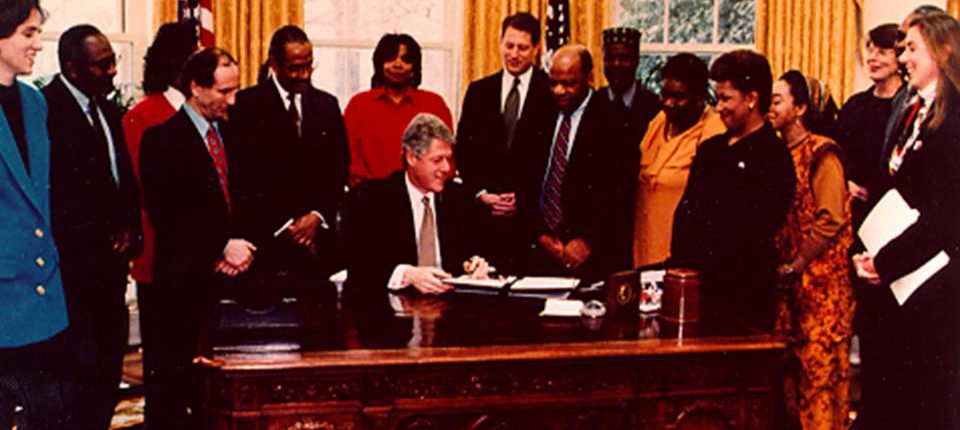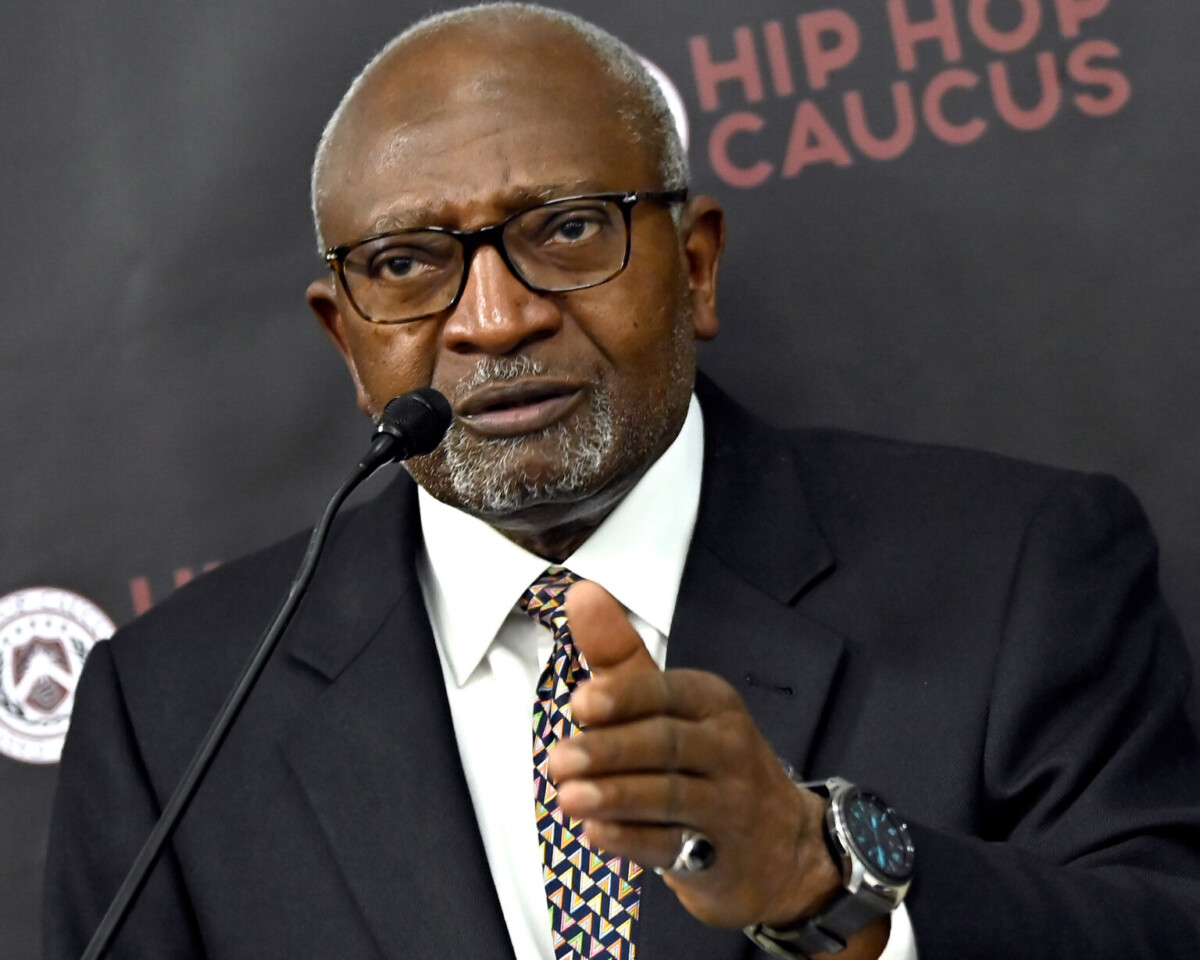 What is the state of the Environmental Justice Executive Order 12898, “Federal Actions to Address Environmental Justice in Minority Populations and Low-Income Populations,” after two decades and three U.S. presidents? Environmental justice leaders in 2014 will commemorate the Executive Order and work on action plans to ensure its full implementation.
This February 11, 2014 will mark the twentieth anniversary of the historic Environmental Justice Executive Order 12898 signed by President Clinton. In celebrating the signing, groups and leaders from around the country are planning special commemoration activities in February and throughout the year.
A National Planning Committee was formed to support the planning of commemoration activities with the goal of placing environmental justice back on the national radar through various types of commemoration events: release of new books, reports and videos; press and community briefings; host speaker series; city proclamations and petitions; EJ Report Card release; forums and town hall meetings; lecture series; contests, essays and posters; marches and demonstrations; Environmental Justice “Hero” and “Shero” awards; celebrity endorsements; environmental justice film festival; Environmental Justice Day Fair; community events built around geographic information system (GIS) and toxic release inventory (TRI) mapping; and intergenerational activities involving kids, youth, young adults and elders.
Although the EJ Executive Order was signed by President Clinton nearly 20 years ago, it has never been fully implemented. The Executive Order was signed in 1994 on the second day of the National Institute for Environmental Health Sciences (NIEHS) "Health and Research Needs to Ensure Environmental Justice" in Arlington, VA.
After lying dormant for nearly a decade under the George W. Bush administration, the EJ Executive Order received some new life in 2010 under the Obama administration--with the reinvigoration of the Interagency Working Group (IWG) that called for updating more than a dozen agencies' EJ strategic plans and Plan EJ 2014, a roadmap that will help EPA integrate environmental justice into its programs, policies, and activities. The goals of the plan are to: Protect health in communities over-burdened by pollution; empower communities to take action to improve their health and environment; and establish partnerships with local, state, tribal and federal organizations to achieve healthy and sustainable communities.
Clearly, a lot has happened in twenty years since those of us who were summoned to the White House signing on that cold snowy day in February. We have made progress, but much more work still remains. Because of research, policy work and grassroots mobilization, we know much more today than we did two decades ago. From 1990-1993, Dumping in Dixie topped the list of only a half dozen environmental justice books in print. In 1994, five additional environmental justice books were added to the list. Environmental justice research, writing, and publications have flourished over the years. Today, there are hundreds of environmental justice books covering a wide range of disciplines spanning the globe. Environmental justice courses and curricula can be found at nearly every college and university in the U.S. This was not always the case. An expanding “pipeline” of diverse scholars, scientists, researchers, policy analysts, and community leaders is leading on environmental justice, including climate change and vulnerable communities. Despite this progress, frontline communities and their leaders are demanding that environmental justice be made a centerpiece in closing the gap in climate action plans, energy policies, transportation initiatives, and disaster management which still leave too many low-wealth communities and people of color behind.
In 1994, there were just four university-based environmental justice centers. It is no accident that all of these early environmental justice centers were located at historically black colleges and universities (HBCUs). Today, there are dozens of university-based environmental justice centers and 22 legal clinics that list environmental justice as a core area, and six academic programs that grant degrees in environmental justice, including one legal program. Prior to 1994, only a couple of EJ leaders had won national recognition and environmental awards for their work. In the past two decades, more than two-dozen environmental justice leaders have won prestigious national awards, including the Heinz Award, Goldman Prize, MacArthur "Genius" Fellowship, Ford Foundation Leadership for a Changing World Award, Robert Wood Johnson Community Health Leaders Award, and others. Just this year, Kimberly Wasserman Nieto of the Little Village Environmental Justice Organization (LVEJO) won the Goldman Prize for her collaborative work with her allies for shutting down the Fisk and Crawford coal plants in Chicago.
In 1994, only four states (Louisiana, Connecticut, Virginia, and Texas) had a law or an executive order on environmental justice. Twenty years later, all 50 states and the District of Columbia have instituted some type of environmental justice law, executive order, or policy, indicating that the area of environmental justice continues to grow and mature.
The number of people of color environmental groups that support the Environmental Justice Movement has grown from 400 groups in 1994 to more than 3,000 groups and a dozen networks in 2013. Despite its success, funding support for environmental justice has been piecemeal. For example, environmental funders spent a whopping $10 billion between 2000 and 2009. However, only a stingy 15 percent of the environmental grant dollars benefitted marginalized communities, and only 11 percent went to advancing "social justice" causes, such as community organizing and capacity building. Constrained funding has made it difficult for building organizational infrastructure, leadership development and participating effectively in the policy arena. Clearly, much more is needed in 2014 to ensure that all Americans enjoy healthy, livable and sustainable communities.
The National Planning Committee is supported by staff from the Barbara Jordan-Mickey Leland School of Public Affairs at Texas Southern University. For further information, contact Dr. Glenn S. Johnson at (713) 313-4845 or johnsongs@tsu.edu.
What is the state of the Environmental Justice Executive Order 12898, “Federal Actions to Address Environmental Justice in Minority Populations and Low-Income Populations,” after two decades and three U.S. presidents? Environmental justice leaders in 2014 will commemorate the Executive Order and work on action plans to ensure its full implementation.
This February 11, 2014 will mark the twentieth anniversary of the historic Environmental Justice Executive Order 12898 signed by President Clinton. In celebrating the signing, groups and leaders from around the country are planning special commemoration activities in February and throughout the year.
A National Planning Committee was formed to support the planning of commemoration activities with the goal of placing environmental justice back on the national radar through various types of commemoration events: release of new books, reports and videos; press and community briefings; host speaker series; city proclamations and petitions; EJ Report Card release; forums and town hall meetings; lecture series; contests, essays and posters; marches and demonstrations; Environmental Justice “Hero” and “Shero” awards; celebrity endorsements; environmental justice film festival; Environmental Justice Day Fair; community events built around geographic information system (GIS) and toxic release inventory (TRI) mapping; and intergenerational activities involving kids, youth, young adults and elders.
Although the EJ Executive Order was signed by President Clinton nearly 20 years ago, it has never been fully implemented. The Executive Order was signed in 1994 on the second day of the National Institute for Environmental Health Sciences (NIEHS) "Health and Research Needs to Ensure Environmental Justice" in Arlington, VA.
After lying dormant for nearly a decade under the George W. Bush administration, the EJ Executive Order received some new life in 2010 under the Obama administration--with the reinvigoration of the Interagency Working Group (IWG) that called for updating more than a dozen agencies' EJ strategic plans and Plan EJ 2014, a roadmap that will help EPA integrate environmental justice into its programs, policies, and activities. The goals of the plan are to: Protect health in communities over-burdened by pollution; empower communities to take action to improve their health and environment; and establish partnerships with local, state, tribal and federal organizations to achieve healthy and sustainable communities.
Clearly, a lot has happened in twenty years since those of us who were summoned to the White House signing on that cold snowy day in February. We have made progress, but much more work still remains. Because of research, policy work and grassroots mobilization, we know much more today than we did two decades ago. From 1990-1993, Dumping in Dixie topped the list of only a half dozen environmental justice books in print. In 1994, five additional environmental justice books were added to the list. Environmental justice research, writing, and publications have flourished over the years. Today, there are hundreds of environmental justice books covering a wide range of disciplines spanning the globe. Environmental justice courses and curricula can be found at nearly every college and university in the U.S. This was not always the case. An expanding “pipeline” of diverse scholars, scientists, researchers, policy analysts, and community leaders is leading on environmental justice, including climate change and vulnerable communities. Despite this progress, frontline communities and their leaders are demanding that environmental justice be made a centerpiece in closing the gap in climate action plans, energy policies, transportation initiatives, and disaster management which still leave too many low-wealth communities and people of color behind.
In 1994, there were just four university-based environmental justice centers. It is no accident that all of these early environmental justice centers were located at historically black colleges and universities (HBCUs). Today, there are dozens of university-based environmental justice centers and 22 legal clinics that list environmental justice as a core area, and six academic programs that grant degrees in environmental justice, including one legal program. Prior to 1994, only a couple of EJ leaders had won national recognition and environmental awards for their work. In the past two decades, more than two-dozen environmental justice leaders have won prestigious national awards, including the Heinz Award, Goldman Prize, MacArthur "Genius" Fellowship, Ford Foundation Leadership for a Changing World Award, Robert Wood Johnson Community Health Leaders Award, and others. Just this year, Kimberly Wasserman Nieto of the Little Village Environmental Justice Organization (LVEJO) won the Goldman Prize for her collaborative work with her allies for shutting down the Fisk and Crawford coal plants in Chicago.
In 1994, only four states (Louisiana, Connecticut, Virginia, and Texas) had a law or an executive order on environmental justice. Twenty years later, all 50 states and the District of Columbia have instituted some type of environmental justice law, executive order, or policy, indicating that the area of environmental justice continues to grow and mature.
The number of people of color environmental groups that support the Environmental Justice Movement has grown from 400 groups in 1994 to more than 3,000 groups and a dozen networks in 2013. Despite its success, funding support for environmental justice has been piecemeal. For example, environmental funders spent a whopping $10 billion between 2000 and 2009. However, only a stingy 15 percent of the environmental grant dollars benefitted marginalized communities, and only 11 percent went to advancing "social justice" causes, such as community organizing and capacity building. Constrained funding has made it difficult for building organizational infrastructure, leadership development and participating effectively in the policy arena. Clearly, much more is needed in 2014 to ensure that all Americans enjoy healthy, livable and sustainable communities.
The National Planning Committee is supported by staff from the Barbara Jordan-Mickey Leland School of Public Affairs at Texas Southern University. For further information, contact Dr. Glenn S. Johnson at (713) 313-4845 or johnsongs@tsu.edu.
MSU Sociology!: Renowned environmentalist Dr. Robert D. Bullard speaks on campus as part of Kaplowitz Lecture Series
The College of Social Science welcomed Robert D. Bullard, PhD...





